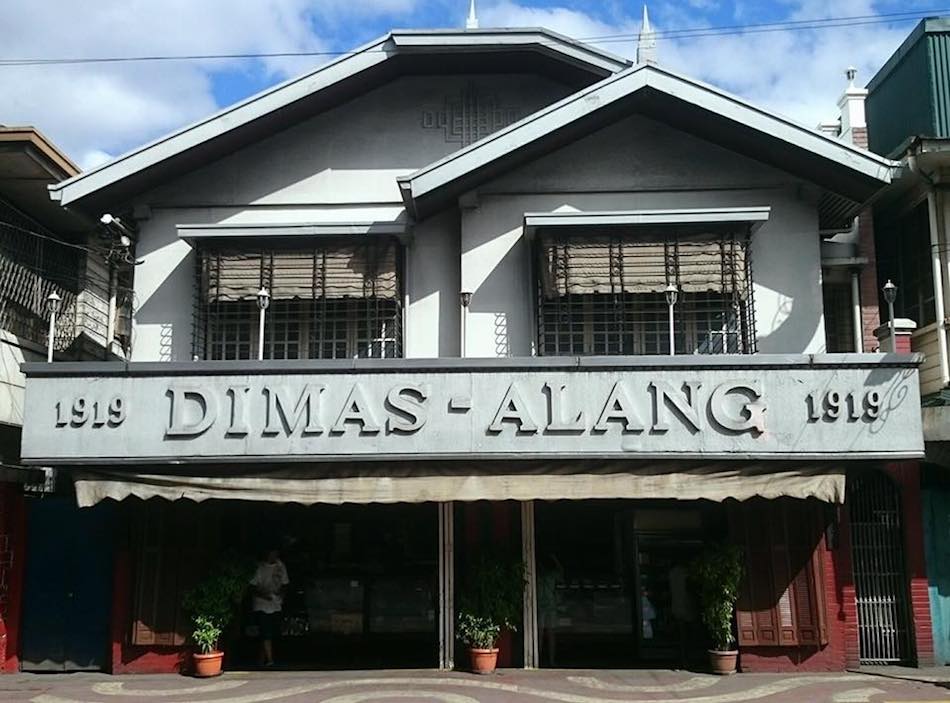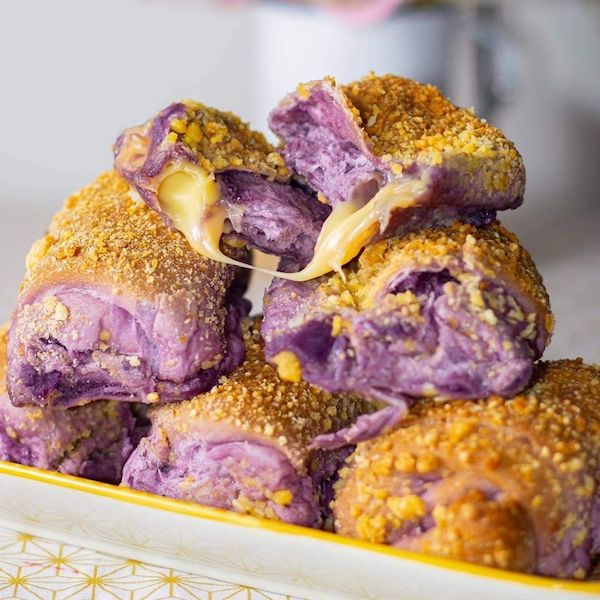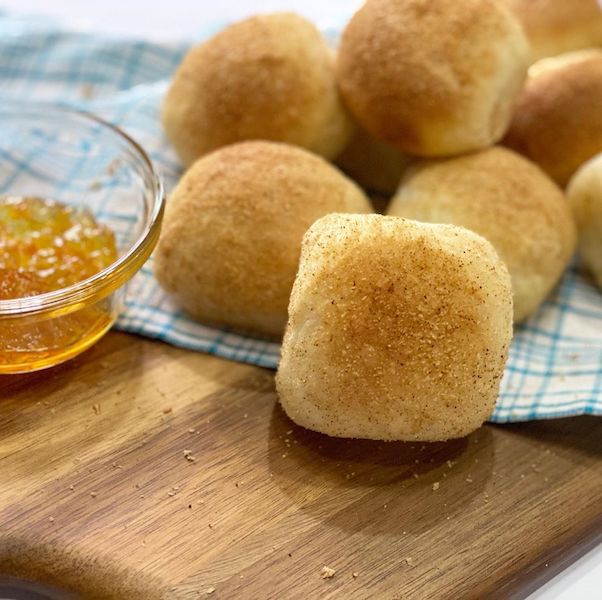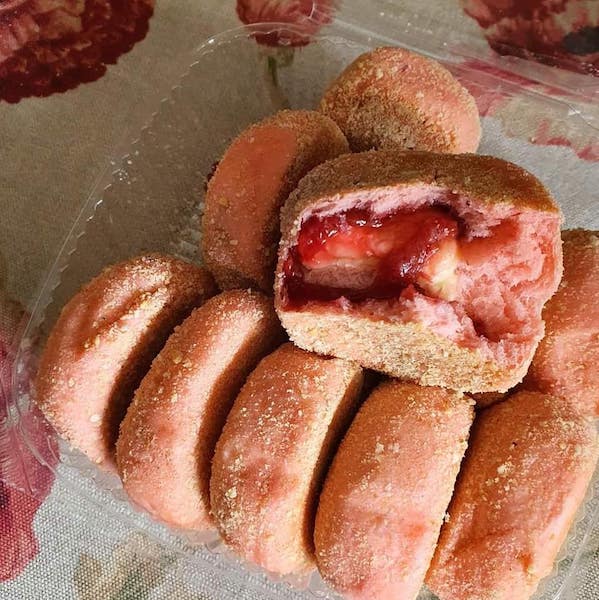The rise and rise of flavored pandesal, or how a humble bread became a canvas for Pinoy creativity
ADVERTISEMENT

Welcome, Kapamilya! We use cookies to improve your browsing experience. Continuing to use this site means you agree to our use of cookies. Tell me more!
The rise and rise of flavored pandesal, or how a humble bread became a canvas for Pinoy creativity
RHIA D. GRANA
Published Oct 18, 2020 12:13 PM PHT
|
Updated Oct 25, 2020 09:22 PM PHT
Time was when a perfect morning simply consisted of warm, freshly baked pandesal bought from the neighborhood panaderia. Slightly crunchy on the outside, soft, airy and chewy on the inside. Bread not too sweet, so we’d either dunk it in our coffee, dip it in champorado, or consume it with our choice of palaman—cheddar cheese (kesong puti, if we got lucky to find one in the palengke), coco jam, or peanut butter.
Time was when a perfect morning simply consisted of warm, freshly baked pandesal bought from the neighborhood panaderia. Slightly crunchy on the outside, soft, airy and chewy on the inside. Bread not too sweet, so we’d either dunk it in our coffee, dip it in champorado, or consume it with our choice of palaman—cheddar cheese (kesong puti, if we got lucky to find one in the palengke), coco jam, or peanut butter.
The panaderia in our place in Cavite used gas ovens. But back in the olden days, pandesal was cooked in a pugon, or wood-fired oven, says Jenny Orillos, one of the authors of Panaderia: Philippine Bread, Biscuit and Bakery Traditions. The popularity of this tradition, however, diminished after the ban on the cutting of the bakawan (mangroves) which was used as fuel. And then there was the rise of the gas oven.
The panaderia in our place in Cavite used gas ovens. But back in the olden days, pandesal was cooked in a pugon, or wood-fired oven, says Jenny Orillos, one of the authors of Panaderia: Philippine Bread, Biscuit and Bakery Traditions. The popularity of this tradition, however, diminished after the ban on the cutting of the bakawan (mangroves) which was used as fuel. And then there was the rise of the gas oven.
One of the oldest surviving bakeries that still uses the pugon is Panaderia Dimas-alang in Pasig City. Founded in 1919, the panaderia also stayed true to the traditional pandesal recipe, which has “a hint of salt and the breath of the wood-fired oven clinging to its light, crisp crust,” Orillos wrote in an article for Grid magazine.
One of the oldest surviving bakeries that still uses the pugon is Panaderia Dimas-alang in Pasig City. Founded in 1919, the panaderia also stayed true to the traditional pandesal recipe, which has “a hint of salt and the breath of the wood-fired oven clinging to its light, crisp crust,” Orillos wrote in an article for Grid magazine.
“It is the pandesal that most recognize: a small, oval bread with a brown crust, dusted with breadcrumbs, and narrow, pointed leaf-like edges on the top that distinguishes it from an ordinary dinner roll. This type of pandesalis baked on a half-sheet pan (plancha) hence it’s also known as pandesal de plancha,” she added.
“It is the pandesal that most recognize: a small, oval bread with a brown crust, dusted with breadcrumbs, and narrow, pointed leaf-like edges on the top that distinguishes it from an ordinary dinner roll. This type of pandesalis baked on a half-sheet pan (plancha) hence it’s also known as pandesal de plancha,” she added.
ADVERTISEMENT
Before, bakers did everything entirely by hand. But even with the advent of mixers, bakers continued to shape the pandesal by fingers and palm, retaining the distinctive pointed mark on top that bakers call the singkit, or gatla—a notch.
Before, bakers did everything entirely by hand. But even with the advent of mixers, bakers continued to shape the pandesal by fingers and palm, retaining the distinctive pointed mark on top that bakers call the singkit, or gatla—a notch.
Over time, made available in supermarkets and in some panaderias are the rounded, less crusty, soft and lighter colored pandesal. “It deviates from the origin of its name—bread of salt. If you compare the formulations, the ‘new’ pandesal has 18% sugar while the old-fashioned has only 1.75%,” said Orillos.
Over time, made available in supermarkets and in some panaderias are the rounded, less crusty, soft and lighter colored pandesal. “It deviates from the origin of its name—bread of salt. If you compare the formulations, the ‘new’ pandesal has 18% sugar while the old-fashioned has only 1.75%,” said Orillos.
As the variables change—“the move from manual mixing to machine mixers, baking in a pugon to gas ovens, using fresh or active dry yeast to instant dry yeast (reducing fermentation time),” as per Orillos—the pandesal naturally moves farther away from the traditional breakfast staple older Filipinos enjoyed.
As the variables change—“the move from manual mixing to machine mixers, baking in a pugon to gas ovens, using fresh or active dry yeast to instant dry yeast (reducing fermentation time),” as per Orillos—the pandesal naturally moves farther away from the traditional breakfast staple older Filipinos enjoyed.
The rise of flavored pandesal
The rise of flavored pandesal
In recent years, we have seen quite a number of home bakers offering flavored pandesal online. The variants available have been surprising, going beyond the usual ube or ube-cheese combo. Now there’s matcha pandesal, chocolate, red velvet, Nutella, butternut-flavored, blueberry-flavored, strawberry cream cheese-flavored, and more.
In recent years, we have seen quite a number of home bakers offering flavored pandesal online. The variants available have been surprising, going beyond the usual ube or ube-cheese combo. Now there’s matcha pandesal, chocolate, red velvet, Nutella, butternut-flavored, blueberry-flavored, strawberry cream cheese-flavored, and more.
How did this come about?
How did this come about?
ADVERTISEMENT
Actually, it wasn’t the purple tuber that started the flavored pandesal craze, but the vitamin-rich malunggay and kalabasa. “It came about as an indirect response of the local baking industry to the Philippine Food Fortification Act of 2000. The law required adding vitamins to staples such as wheat flour, etc. So the goal was geared towards healthy eating,” Orillos told ANCX.
Actually, it wasn’t the purple tuber that started the flavored pandesal craze, but the vitamin-rich malunggay and kalabasa. “It came about as an indirect response of the local baking industry to the Philippine Food Fortification Act of 2000. The law required adding vitamins to staples such as wheat flour, etc. So the goal was geared towards healthy eating,” Orillos told ANCX.
Known pastry chef Jackie Ang Po noted that the savory types, the ones that featured a palaman or stuffing, such as the corned beef, tuna and asado pandesal have also been around for many years.
Known pastry chef Jackie Ang Po noted that the savory types, the ones that featured a palaman or stuffing, such as the corned beef, tuna and asado pandesal have also been around for many years.
Ube, on the other hand, has been getting international attention for the past few years. Filipino-Americans have been posting anything ube on Instagram so the popularity of ube pandesal didn’t surprise Orillos at all. “Ube is a very happy color and the ube pandesal has that pleasant surprise in the middle, courtesy of the filling of either ube haleya or cheese or both.”
Ube, on the other hand, has been getting international attention for the past few years. Filipino-Americans have been posting anything ube on Instagram so the popularity of ube pandesal didn’t surprise Orillos at all. “Ube is a very happy color and the ube pandesal has that pleasant surprise in the middle, courtesy of the filling of either ube haleya or cheese or both.”
While the popularity of ube pandesal took off during the lockdown, recipes and tutorials can be traced on YouTube and a few Filipino food books even before 2020.
While the popularity of ube pandesal took off during the lockdown, recipes and tutorials can be traced on YouTube and a few Filipino food books even before 2020.
Also, Pinoys are naturally drawn to sweets, so when ube became popular, bakers started exploring other pandesal flavors. “We needed something colorful and sweet and happy to counteract the heartbreak and horrors of this pandemic,” said Orillos.
Also, Pinoys are naturally drawn to sweets, so when ube became popular, bakers started exploring other pandesal flavors. “We needed something colorful and sweet and happy to counteract the heartbreak and horrors of this pandemic,” said Orillos.
ADVERTISEMENT
She observed that many of the ones who make and sell flavored pandesal are home-based, with some probably just learning to bake for the first time. “Since lockdown happened, everyone started baking or learning to bake. And with the availability of recipes and tutorials online, the home bakers were quick to learn” said the author.
She observed that many of the ones who make and sell flavored pandesal are home-based, with some probably just learning to bake for the first time. “Since lockdown happened, everyone started baking or learning to bake. And with the availability of recipes and tutorials online, the home bakers were quick to learn” said the author.
The future of pandesal
The future of pandesal
Orillos loves the idea of how the pandesal became a canvas for the Filipino home bakers’ creativity. “The panaderia offers us our daily bread, the staple bread types that will always be part of our dining tables. The home bakers give us the fancier, more expensive versions,” she said. While both groups can offer what the other does, the home bakers are most often more adventurous in trying out new things.
Orillos loves the idea of how the pandesal became a canvas for the Filipino home bakers’ creativity. “The panaderia offers us our daily bread, the staple bread types that will always be part of our dining tables. The home bakers give us the fancier, more expensive versions,” she said. While both groups can offer what the other does, the home bakers are most often more adventurous in trying out new things.
A member of the Culinary Historians of the Philippines, Orillos expects the trend of jazzing up the pandesal to continue in the next year or so, defining the tastes of this period, “much like how the hot pandesal craze is forever linked with the 1970s.” These flavored pandesal have now become a marker of a generation, she said.
A member of the Culinary Historians of the Philippines, Orillos expects the trend of jazzing up the pandesal to continue in the next year or so, defining the tastes of this period, “much like how the hot pandesal craze is forever linked with the 1970s.” These flavored pandesal have now become a marker of a generation, she said.
Not everyone welcomes the idea though. Epicure Joel Binamira isn’t a fan of this food trend. “A good old-fashioned pandesal is a perfect baked good. A canvas for featuring great jams, spreads, cheeses etc. Why mess with a classic? Why flavor it with ube? Just because we can,” he said. “People need to recognize when they have a good thing, and just leave it be. Ube pandesal? I’m not a fan, and 97+% of people who make don’t even use real ube?! Instead they use an artificially colored and flavored powder?!” he said.
Not everyone welcomes the idea though. Epicure Joel Binamira isn’t a fan of this food trend. “A good old-fashioned pandesal is a perfect baked good. A canvas for featuring great jams, spreads, cheeses etc. Why mess with a classic? Why flavor it with ube? Just because we can,” he said. “People need to recognize when they have a good thing, and just leave it be. Ube pandesal? I’m not a fan, and 97+% of people who make don’t even use real ube?! Instead they use an artificially colored and flavored powder?!” he said.
Chef Jackie, on the other hand, advises bakers to be more discerning in coming up with pandesal flavor variants. “Yung iba kasi, ubod ng daming coloring at flavoring—orange, strawberry, lemon. Hindi na bagay,” she pointed out. Ube and cheese is a hands-down good flavor combo, the Chef assures. (You can try her recipe through this link.)
Chef Jackie, on the other hand, advises bakers to be more discerning in coming up with pandesal flavor variants. “Yung iba kasi, ubod ng daming coloring at flavoring—orange, strawberry, lemon. Hindi na bagay,” she pointed out. Ube and cheese is a hands-down good flavor combo, the Chef assures. (You can try her recipe through this link.)
ADVERTISEMENT
The Fleur De Lys chef also noticed technical errors committed by some bakers. “Yung iba kasi kulubot ang pandesal—meaning, underbaked or over-proofed,” she said. Proofing refers to the rest period or amount of time that the fermentation action of the yeast occurs, causing the dough to rise and create an airy texture.
The Fleur De Lys chef also noticed technical errors committed by some bakers. “Yung iba kasi kulubot ang pandesal—meaning, underbaked or over-proofed,” she said. Proofing refers to the rest period or amount of time that the fermentation action of the yeast occurs, causing the dough to rise and create an airy texture.
For Chef Jackie, the characteristics of a perfectly baked pandesal is pretty simple. “Dapat crusty outside, soft inside. Makinis, hindi kulubot. Tapos dapat may bread crumbs para matawag na pandesal,” she says.
For Chef Jackie, the characteristics of a perfectly baked pandesal is pretty simple. “Dapat crusty outside, soft inside. Makinis, hindi kulubot. Tapos dapat may bread crumbs para matawag na pandesal,” she says.
But as we see the prospects and possibilities for the humble and timeless pandesal growing, Orillos hopes we don’t lose our sense of history and identity that are ingrained in the traditional Filipino table staple. “The pandesal of old is a testament of generations of Filipino panaderos who learned to make it from the maestro panadero,” said Orillos. “That is our bread, then and now.”
But as we see the prospects and possibilities for the humble and timeless pandesal growing, Orillos hopes we don’t lose our sense of history and identity that are ingrained in the traditional Filipino table staple. “The pandesal of old is a testament of generations of Filipino panaderos who learned to make it from the maestro panadero,” said Orillos. “That is our bread, then and now.”
ADVERTISEMENT
ADVERTISEMENT






